Henchmen #1(Robot Paper $4.99)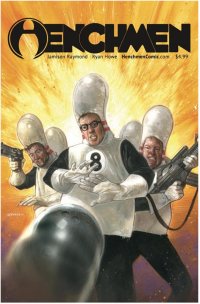
Unmasked #2 (Gestalt $1.99)
By Cat Taylor
This is going to sound crazy but until earlier this week, I had never read a comic book online. There are multiple reasons for that including the comfort and portability of a hard-copy comic as opposed to a laptop computer, my lack of a “cloud” and therefore lack of sufficient storage space for online comic purchases, and my perception that it would be an uncomfortable experience based on my feelings about reading long text stories online. The first two reasons still apply, but since I gave it a shot for these reviews, I have to admit I was blown away by the online comic-reading experience and actually love the way the panels enlarge, flip from one to the next, and sometimes zoom in on important areas of a panel. Old habits die hard but I actually found the visual appeal of reading comic books online to be preferable to reading them in print format. I’m not ready to completely switch over due to the first two reasons but I’m much more open-minded to the format now. Look at me! Ain’t I cutting edge for trying out a format that’s only been around for about ten years now? I may get really bold and try out one of those newfangled cellular telephones next.
So, with this new online reading experience, how can someone know what to check out? After all, there are probably thousands of independently produced online comics. For me, it boiled down to judging a book by its cover (and plot synopsis). In the case of Henchmen, it was the image of all these goofy guys dressed as bowling pins, complete with their own individual numbers. The image was reminiscent of the silly “themed” henchmen on the old Adam West “Batman” TV series but even more ridiculous if you can believe that. As silly as the cover image is, this book isn’t a complete slapstick farce. In fact it walks a razor’s edge between being a look into the human psyche of what would cause a decent person to follow a criminal mastermind and being something akin to the Tick. The format of how this is accomplished is similar to the old “Abbott and Costello meet the Universal monsters” movies, where Abbott and Costello played their parts for laughs but the monsters played their parts completely straight. Here, the comic relief is provided by the arch-villain, Headpin, and the superhero nemesis, Striker. Yes, these are all bowling themed characters and they’re as ridiculous as you would expect. Headpin has nine bowling pin henchmen who cluelessly follow his blatantly incompetent lead and apathy for their safety. For all of them, it’s just business as usual and nothing out of the ordinary because that’s just the way things are done between costumed superheroes and villains. The story makes the transparent comparison to the incompetence of management in the corporate world doing things because that’s just the way they do them. Granted, that kind of social critique is low-hanging fruit but it’s also something that I’m sure everyone who has ever held a job has felt at some point.
To Gary, the main character of the story, the idiocy of blindly following Headpin is completely obvious during the first mission and with just a little basic common sense, he quickly becomes more than just another henchman. The story of how Gary became involved as a henchmen for a supervillain reminds me a little of Walter White’s journey to the dark side on “Breaking Bad.” In Henchmen, Gary is a man who is driven to crime out of desperation when he loses his job and his wife on the same day, a situation which I can unfortunately identify with all too well.* While it isn’t exactly the same as “Breaking Bad”, the similarity is that we are witnessing a basically good character letting desperation drive him to crime and watching where that journey is headed.
It’s difficult to come up with something new in the superhero genre, and even more difficult to balance serious human pathos with slapstick comedy. When done well and with the appropriate balance, you get “Dr. Horrible’s Sing-a-long Blog”. Done poorly you get “Tyler Perry presents: Madea meets the Watchmen.” Yet, this little independent comic, written by someone I’ve never heard of (Jamison Raymond), already shows the potential to be the best new comic book series of 2014. Even more surprising is that the artwork is very polished and well-laid out. Even in the best independent comics, the art typically has much rougher edges than is shown here. Like the writing, Ryan Howe’s artwork achieves an appropriate balance between children’s cartoons and Marvel house-style, and his layouts and panel structures are as good as it gets. It’s possible that I’m overpraising this book based on low expectations and giving the benefit of the doubt to an underdog because it’s not a perfect book. For instance, the supporting characters seem extremely one-dimensional. However, I like what I see so far and believe there is a lot of potential for Gary’s journey to become more interesting while getting a few more laughs in at whatever the next ridiculously themed villain may be. Moreover, this book got off the ground due to a Kickstarter campaign and is apparently the first in an attempt to launch a new independent publishing company. On that note, it’s a very good start. I do think they’ll have to find some advertising if they are going to continue though, because even with the Kickstarter dollars this issue has a $4.99 price tag. As impressive as the story and art are, I imagine a lot of people are going to find it difficult to take a chance on a book with no brand recognition that has a higher than normal price tag.
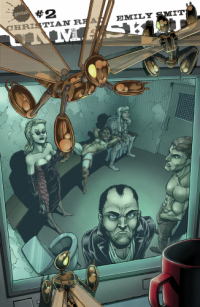 My second online reading assignment for this week was the second issue of Unmasked. Like Henchmen, this comic explores the unexamined life of costumed villains. The villain stars of this book are a couple who have retired from supervillainry to the mundane world of the civilian. As they are living the boring domestic life, someone finds them and offers them a heist job. It’s the kind of crime that’s far beneath the skill-level of these former supervillains but it’s low profile enough and an opportunity for a nice payday. So they decide to take the assignment.
My second online reading assignment for this week was the second issue of Unmasked. Like Henchmen, this comic explores the unexamined life of costumed villains. The villain stars of this book are a couple who have retired from supervillainry to the mundane world of the civilian. As they are living the boring domestic life, someone finds them and offers them a heist job. It’s the kind of crime that’s far beneath the skill-level of these former supervillains but it’s low profile enough and an opportunity for a nice payday. So they decide to take the assignment.
During the course of the story, we witness the taken-for-granted details of the supervillain life that are almost never discussed in the main titles of the “Big Two” comic book publishers. The most interesting aspect to me was the details about how to sufficiently hide the take from a big heist. You can’t put that much money into a bank or go on a spending spree without arousing attention. It’s also not too safe to keep that much money just lying around the house. Other situations explored in this issue are the slippery slope of how one job leads to another, the adrenaline rush of the crimes, and the difference between a criminal and a supervillain. Hint: It’s not about the superpowers. It’s about motivation and the kinds of crimes they commit.
Emily Smith’s artwork for Unmasked also shows a high level of competence. I would rank it high enough to compete with most of the published comic book work on the shelves. There’s something about it that is mainstream enough to fit in with standard superhero comics yet it smacks of an independent “house style,” if there were such a thing. The one criticism I have of the art is that as good as it is, the overly cartoony style is inconsistent with the graphic themes of Christian Read’s story.
While it seems like everything that could be said about superhero comics has already been deconstructed and reconstructed to death, both Henchmen and Unmasked manage to find approaches to supervillain deconstruction that I haven’t seen done quite to this level. However, these are very different books. Henchmen takes an approach that is relatable to the average Joe and while having some campy fun. Unmasked, on the other hand, takes itself very seriously and uses images of graphic violence and sex to make sure you know it’s not a book for kids. While the subject matter of both books is refreshing, the “grim and gritty” approach of Unmasked felt a bit stale at times. There is also a lot potential for new and interesting stories with the concept of Henchmen. Whereas, I can see Unmasked becoming an average quality superhero comic in just a few more issues, relying more on “mature content” and villain victories in an attempt to set itself apart. Hopefully, both books stay fresh and keep the new ideas coming.
*Disclaimer: Although experiencing a similar situation, I have not turned to crime, nor have I ever dressed up like a bowling pin, but keep poking the bear and we’ll see.
Henchmen Rating: 




Out of a Possible 5 Stars
Unmasked Rating: 




Out of a Possible 5 Stars
Batman and Robin Annual #2 (DC Comics, $4.99)
By Devon Sanders
In Batman and Robin Annual #2, I have found everything that is good and bad about DC’s New 52.
It had promise. It tried but quite possibly tried too hard. That’s the thing about the New 52. It just has to try a little too hard.
The promise and premise of Batman and Robin Annual #1 is a simple one; an unknown tale of the original Robin, Dick Grayson’s first mission as Robin; his relationship with Batman and how it filters through to their shared future relationship with Damian Wayne. The issue is that in a New 52, it just feels a bit small and half-told.
Writer Peter Tomasi does his best within the space given to provide proper characterization to all and does but in this small of a space, all it does is make me wish Damian Wayne even more and made me realize that he just may have been DC Comics’ last “sensational character find”.
Artist Doug Mahnke does his usual bang-up job on visuals giving his young Dick Grayson a bearing that suggests action, mischief and adventure, in short, a true Robin while making you wish he had opportunities to draw Damian Wayne. Hopefully, this is a signal more work for Mahnke in the Batman camp. As a reader who’s followed his stellar and reliable work from Superman, Justice League, Batman and Green Lantern, I truly hope this is the case.
Batman and Robin Annual #2 has the two main things that made me a massive DC Comics fan: Batman and Robin. Only in this New 52 story, it feels like I’ve been here before and in and of itself, that’s not a bad place to be.
It just feels a bit like looking back over your shoulder and seeing this place you loved growing a bit smaller with every step you’ve taken away from it.
Rating: 




Out of a Possible 5 Stars
 World War Mob #1 ($1.99, New Paradigm)
World War Mob #1 ($1.99, New Paradigm)
by D.S. Randlett (@dsrandlett)
One of the lasting legacies of Garth Ennis’ Preacher (and his run on the MAX flavor of The Punisher), and likely its most important, was the rebirth of the War Comic. The genre had died off, and it’s easy to quickly get an idea of why that might be. The post World War II days in America were probably the heyday of the genre, a place where victory could be reflected on, but most of all glorified. Although, to Joe Kubert’s credit, he was able to capture a certain sense of weariness and homesickness even as Sgt. Rock engaged in some pretty “War Lite” versions of World War II. As the years wore on, and America more and more embraced a destiny of empire, the War Comic must have been harder and harder to enjoy. The genre died before comic books were considered adult-appropriate, and as such there was never a moment in comics like All Quiet on The Western Front or The Best Years of Our Lives where the cold hard truths of war, its costs and its scars, could be reckoned with within the medium.
And I would argue that the War Comic still has not had that moment, or at least not one of terribly great import. The genre’s most prolific writer, Garth Ennis, tends to riff on movies. The best War Comic to come from the rebirth of the genre was, in my estimation, the underrated Sgt. Rock tale Between Hell and a Hard Place, written by Brian Azzarello and drawn by the only man who could ever draw Rock, Joe Kubert, who in that book proved that he had not lost one step with age. Azzarello’s story compels not because of its shattering and sobering analysis of war, but because of the blending of the classic Sgt. Rock template with the crime genre.
The excellent new series, World War Mob, takes a similar tack as that great Sgt. Rock tale. Vito Delsante’s script switches between something like Band of Brothers and something like the original Scarface. The common link between the two is a group of five G.I.s who were mob enforcers before they shipped out, and who now find themselves enlisted by their boss to kill none other than Benito Mussolini, and to do this they must go AWOL. At this point, near the end of the War, Mussolini has been deposed, and reinstalled as a sort of figurehead by Hitler. He is now surrounded by what can only be called a crew, himself just another boss. But it’s the characters that intrigue here, as their’s has always been a story I’ve been interested in seeing, as most of the great post-War mob pictures usually feature a character who was in the War. What kind of guy is that? World War Mob looks to answer that question. As yet, only two of the five members of the Mussolini Murder Squad (my formulation, for the record) have been introduced. But even so, the story here is incredibly worthwhile, as their introductions are both concerned with showing how these men are affected by the violence that they have had to inflict in both sides of their lives. It’s very rich stuff, but it’s not without a sense of humor and, yes, a sense of fun.
The art by Giancarlo Caracuzzo really sells it. There’s definitely a Kubert influence here, but the style is much cleaner. It fits with the slicked back gangster side of the book, but it also helps the explosions of violence feel more shocking when they come. It’s in the art that World War Mob finds its footing as a mafia tale. Clean and appealing exteriors hide an ugly and violent heart. And is that so different from the civilized man who goes to war?
World War Mob is a surprise on every level. The cover promises something derivative of Garth Ennis’ efforts in the War Comics genre, but the interior reveals a story that charts it own path and has a sense of depth that’s rare in any genre.
Rating: 




Out of a Possible 5 Stars
Guardians of the Galaxy #11 (Marvel, $3.99)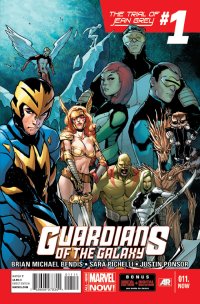
By Adam X. Smith
Well, it’s come to this, folks – with nothing better to do, and my local shop not stocking Miracleman #2, I’m rounding out my trilogy of All-New Marvel Now! titles with yet another book that isn’t actually all-new. However, since I’ve not read it previously, and the whole point of this is to test whether it’s a good jumping-on point for titles or not, this week I’ll be reviewing Guardians of the Galaxy #11 by Brian Michael Bendis and Sarah Pichelli.
Since I’m going for the trifecta here, let’s see if we can break it down a little bit. Firstly, does it re-introduce the characters and concept well for all us Johnny-Come-Latelies?
I guess so, yes. I mean, there’s a whole lot of setting up with Peter Quill aka Star-Lord – he’s on the lam in an alien dive bar (a running joke from what I can tell), his father is an alien king who has put a price on his head for reasons, there’s some stuff about non-intervention into Earth business, and as the cover points out, it’s setting up “The Trial of Jean Grey” storyline that’s supposedly going to be a big crossover this year. In essence, the ruler of the Shi’ar has decided that retro-Jean Grey (who along with the retro-X-Men has arrived in the present for other unrelated reasons) is to stand trial for her crimes against the universe as host of the parasitic Phoenix Force, even though she technically hasn’t committed them yet* and in spite of the fact that they’ve just had to deal with Thanos the Mad Titan trying to blow up the Earth and probably a few others along the way. Or something. I didn’t exactly follow Infinity, like, at all.
Wibbly-wobbly timey-wimey plot logic notwithstanding, the rest of the galactic leaders, including Peter’s dad, just seem to go along with it and the Guardians – who have been hiding out in deep space – are prompted to return to Earth and sort things out when a ship enters our atmosphere and lands in Canada – cue several jokes stemming from canon foreigner and bikini warrior Angela’s question “What is a Canada?”. Unfortunately, they’re too late to prevent the abduction of Jean Grey, so we get a cliffhanger ending that will probably get resolved in the pages of another title. That kind of puts people like me in an awkward situation: even if this ends up being a two-parter in the pages of GotG, I didn’t want to have to buy and read seven different books to follow this story – I wanted to read this one!
So yeah, the A-plot is a bit too much setting up for not a lot of pay-off. Where it shines, though – and this is where I’m a lot more forgiving of the writing – is in the witty banter between Rocket Raccoon and a hologram of Tony Stark and the scenes between Quill, Gamora and Angela – and the Skrull bounty hunter that attempts to capture him at the bar. This part gloriously wrong-footed me by virtue of the fact that I didn’t know these characters inside and out, and it’s the kind of narrative trick that makes Bendis a writer I rarely follow closely but always enjoy. Plus, as Ultimate Spidey fans will no doubt already know, his work with Pichelli is always top-drawer stuff, and when given the job of trying to sell me on these characters as a sort-of less-ridiculous cross between Nextwave and Firefly, the two of them sell the hell out of it.
So there you have it. Characters and dialogue: A+. Plot and pacing: B-, but that comes with the territory. Making me want to read more about their adventures with Tony Stark in space: sold, I’m in. Acting as a point of entry for an ongoing series: C-, but it does a damn sight better job of it than Thunderbolts did.
Rating: 




Out of a Possible 5 Stars
*Neither is it addressed why Jean Grey is being singled out for blame when the Phoenix Force has also possessed literally dozens of other people, including most recently Cyclops, Collossus, Magick and Namor in Avengers vs X-Men – presumably to retroactively absolve her of any residual stigma, much like Hal Jordan’s time as Parallax. But it’s pretty much a given by this point that the Shi’ar are massive arsetools so I’m willing to let it slide for the sake of suspension of disbelief.
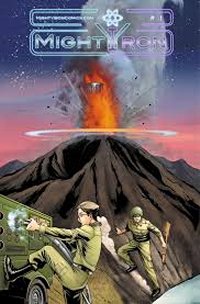 Submit! (to more digital reviews)
Submit! (to more digital reviews)
by Graig Kent
Last week I waded into the pool of 76 new releases from Comixology Submit, the digital comics retailer’s self-published and small-press distribution outlet. There was so much there that I only got through scanning to the “L’s” in the alphabetical listings, which means there’s still so much more interesting stuff to get to. Not to neglect the fact that more books are still being release this week. So let’s just get to it…
It’s always surprising to see a recognizable name in the Submit releases, not that established creators shouldn’t have creator-owned books, but amidst so many upstarts, the recognizable name of writer or artist really stands out. Matt Haley was one of the first artists to draw Dark Horse’s Ghost and Birds of Prey, and jumped around DC and Marvel throughout the late 1990’s and early 2000’s. I always liked his work, he was a bit of a “good girl” artist, but generally an all around solid storyteller. He disappeared into the world of film and television for a while (notably working with on a Stan Lee competition show and the Morgan Spurlock Comic Con movie), but it’s certainly good to see him back. Haley returns with The Mighty Iron #1 (Mighty Iron Comics, $1.99 on Comixology), a story set at the precipice of America’s involvement in WWII on the island of Oahu. Here an Army Signal Corps unit is installing new radar scopes for surface to air surveillance when suddenly an explosion occurs on a point across the island, scattering fiery debris everywhere. Unsure whether it’s volcanic eruption or bomb detonation when things settle, the unit goes to investigate. There they find a most curious crater, flat on the bottom with a metallic sheen. It’s like nothing they’ve ever seen before and how it reacts when tested is even more curious.
At this stage the book is all potential. I have no foresight into where it’s headed, and it’s kind of exciting. We only know a few little tidbits about this object and our cast, but with WWII already raging, there’s all sorts of exterior elements not at all present in this issue ready to rear their heads. Haley’s work is solid, with clean lines and well structured pages, but it’s the Hawaiian island’s vistas that Haley’s just killing it. He establishes a beautiful, tranquil, vast open setting, and rocks it with the explosion, and it’s all brilliant. It would be nothing without the coloring of Nathan Eyring and Tess Fenner. Typically self-published or small press books fare poorly in the coloring department, with novice colorists over-using gradient tones and attempting too much to resemble reality. Here, Eyring and Fenner accentuate the hillsides and sweeping grass fields with a sense of texture rather than color. The skies in the distance are a hazy purple and the aura around the crater is something only made relevant by the color work. It’s a great looking book. The only real weak point is some awkwardly positioned dialogue (the dialogue itself its fine, it’s just on the page oddly in a spot or two) and an abrupt cliffhanger that doesn’t feel like a chapter end. Otherwise The Mighty Iron is quite an engaging read worth checking back in with.
Rating: 




Out of a Possible 5 Stars
Like Matt Haley, Joe St. Pierre is a name I remember well from the 1990’s, primarily as a key contributor to Valiant 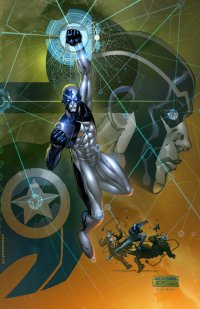 in its heyday, then bouncing around DC and Marvel on fill-ins and short runs all over the place. Like Haley, he seemed to have disappeared into the realm of commercial art, but in recent years he’s been publishing webcomics via his Astronaut Ink studio. Starting life as the “New Zodiax” webcomic, Liberader #1 (Astronaut Ink, $1.99 on Comixology, free @ astronautink.com) is a very 90’s style cyberpunk thriller that owes a heavy gratitude to Hackers, The Lawnmower Man, War Games and even Tron. It’s not a very modern feeling book, but it’s not totally retro either. The dystopian environment of society governed by a corporation is more a modern consideration, but it’s hard to escape the throwback sensation what with all the floating-bodies-in-nebulous-cyberspace imagery.
in its heyday, then bouncing around DC and Marvel on fill-ins and short runs all over the place. Like Haley, he seemed to have disappeared into the realm of commercial art, but in recent years he’s been publishing webcomics via his Astronaut Ink studio. Starting life as the “New Zodiax” webcomic, Liberader #1 (Astronaut Ink, $1.99 on Comixology, free @ astronautink.com) is a very 90’s style cyberpunk thriller that owes a heavy gratitude to Hackers, The Lawnmower Man, War Games and even Tron. It’s not a very modern feeling book, but it’s not totally retro either. The dystopian environment of society governed by a corporation is more a modern consideration, but it’s hard to escape the throwback sensation what with all the floating-bodies-in-nebulous-cyberspace imagery.
Liberader is a thoroughly pro work, with St. Pierre’s densely paneled pages (frequently upwards of 15 panels), graphic underlays, and intriguing arrangement making the story flow exceptionally well, easing you past the cornier aspects of a ’90’s styled cyber-thriller. This first issue is an origin story, of sorts, and in that regards it’s a by-the-numbers affair. Yet the subtle environmental elements are very intriguing, particularly that of the omnipresent Dinosaur Inc. and its influence on world of our main character, Benjamin F, forcing him into his “hacktivism”. It seems everything in Benjamin’s life, the food, school, the police, his home, is controlled, or at least influence by Dinosaur, and none of it for the better. When a pair of cybersmart hitmen start taking out the other hackers in Benjamin’s circle targeting Dinosaur, he can’t help escape the feeling he’s next, and takes proactive action…and fails.
It took some persistence to get past the dated feel of the book, but once I understood it’s genre homage, I was able to relax and enjoy it for what it was. St. Pierre seems to relish the cheesier aspects of the cyberthriller but also doesn’t play into it with camp. It’s a knowingly earnest story from a veteran storyteller which works exactly in that regard.
Rating: 




Out of a Possible 5 Stars